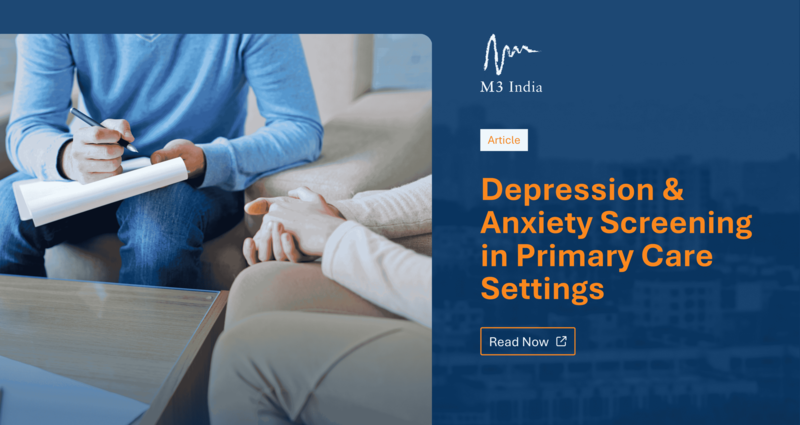Article: Depression and Anxiety Screening in Primary Care
M3 India Newsdesk Apr 25, 2025
Learn more about the strategies primary care providers can use to screen for depression and anxiety disorders to improve health outcomes and patients’ quality of life.
Depression and Anxiety
The world carries a typical burden of mental disorders, and possibly the most common one among all the mental disorders is depression and anxiety. The worldwide prevalence estimate for depression is about 5.5%, and for anxiety is about 3.4% in India. The primary healthcare sector is the first point of contact for addressing these issues and intervening and treating the patients.
This article will provide a more detailed description of the process of screening depression and anxiety, and the anticipated outcomes of the screening methods used.
Why Screen For Depression and Anxiety?
Depressive and anxiety disorders can significantly interfere with the quality of life and relationships. If left untreated, these conditions can result in:
- Decreased productivity and absenteeism
- The increased risk for chronic diseases like diabetes and cardiovascular disease
- Fragmented care with poor treatment adherence
- Higher health care use and costs
Early appropriate treatment of depression and anxiety disorders is associated with better health outcomes and quality of life. [1]
Who Should Be Screened?
The American Academy of Family Physicians (AAFP) recommends all patients undergo screening for depression and anxiety because of these specific criteria:
- People who have suffered from mental health problems before their current adulthood period.
- Adults with long-standing conditions such as heart disease and diabetes require depressive screening.
- Adults with a background of substance abuse.
- Life situations that cause major changes or stressors affect adults similarly.
- People experiencing chronic pain.
- People living in stressful home environments.
- The elderly.
- People who experience social isolation.
- People with unexplained symptoms.[3]
Screening Tools
As per NICE, any patient dealing with depression—especially those with a history of it or those facing a chronic physical illness that affects their daily life—can be asked two important questions:
- Have you often felt down, depressed, or hopeless in the last month?
- Do you hardly find interest or pleasure in doing things? If the answer is "yes", it strongly indicates the presence of depression. Following that, the healthcare provider should ask the following :
- In the past month, have you:
- Feeling bad for anything?
- Unable to concentrate?
- Feeling tired or low?
- Are you eating more or less?
- Sleeping properly?
- Feeling so slowed down?
- Death thoughts?
There are several screening tools available that help professionals pinpoint depression and anxiety through effective assessment methods.
- The Patient Health Questionnaire-9 (PHQ-9): This is a survey that consists of nine questions to evaluate signs of depression. This questionnaire aids in diagnosing the severity of depression based on the diagnostic criteria outlined in the Diagnostic and Statistical Manual - Fourth Edition (DSM-IV). The Scores are categorised as minimal (1-4), mild (5-9), moderate (10-14), moderately severe (15-19), and severe depression (20-27). [4]
- Generalised Anxiety Disorder 7-item scale (GAD-7): This is an assessment tool to help identify signs of anxiety in patients.
- Hospital Anxiety and Depression Scale (HADS): It allows healthcare providers to evaluate both anxiety and depression symptoms. Each scale has seven questions, with scores categorised as normal (0-7), mild (8-10), moderate (11-14), and severe (15-21).
- Kiddie-Sads and Child and Adolescent Psychiatric Assessment: This assessment provides interview tools to detect depressive illness in children and young adults, but NICE reports limited acceptance for these tools in busy routine CAMHS centers due to potential use adjustments.
- CES-D Scale or the RADS: Young people benefit more from completing the CES-D Scale or the RADS as screening tools for adolescent depression.
- Edinburgh Postnatal Depression Scale (EPDS): Puerperal depression evaluation requires the Edinburgh Postnatal Depression Scale (EPDS) since this measuring tool functions as a self-administered rating system.
- Geriatric Depression Scale (GDS): It delivers worthwhile results during assessments with elderly patients.
- Cornell Scale for Depression in Dementia (CSDD): This can be used as an assessment tool for patients with dementia. [5]
Screening Set-ups
- Depression and anxiety screening should become a mandatory part of physical assessment during routine annual patient check-ups.
- Primary care facilities should employ pre-established screening instruments made for their setting.
- Healthcare staff members require training programs that teach them appropriate methods to conduct depression and anxiety screenings and manage related cases.
- Treatment recommendations with optional mental care specialist referrals must be delivered to patients who show signs of depression or anxiety based on their conditions.
- Follow-up appointments with patients enable evaluation progress and even make necessary adjustments as needed. [4]
Challenges & Limitations
One of the major issues is how patients show up in primary care facilities. Many patients are reluctant to share their symptoms of depression or anxiety as they worry about being labelled as "mentally ill." Lack of primary care providers complicates the process of referring patients for further treatment.
Solutions
- Utilising electronic health records (EHRs) and mobile health (mHealth) apps to streamline screening and monitoring processes.
- Collaborate with mental health specialists to facilitate referrals and ensure continuity of care.
- Provide patients with education and resources to help them understand the importance of mental health.
Early detection of depression and anxiety remains vital because it allows quick access to help that leads to better health results for patients. Screening patients and implementing individualised care plans help primary care providers to increase their well-being.
Disclaimer: The views and opinions expressed in this article are those of the author and do not necessarily reflect the official policy or position of M3 India.
About the author of this article: Ms Jyouti Pachisia is a practising dietician and medical content writer from Kolkata.
-
Exclusive Write-ups & Webinars by KOLs
-
Daily Quiz by specialty
-
Paid Market Research Surveys
-
Case discussions, News & Journals' summaries
